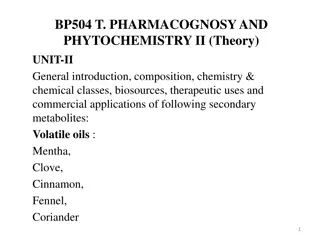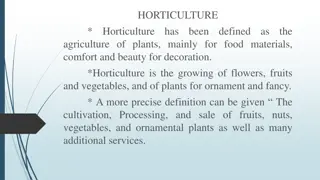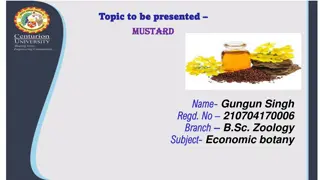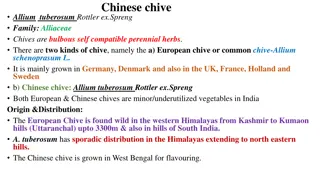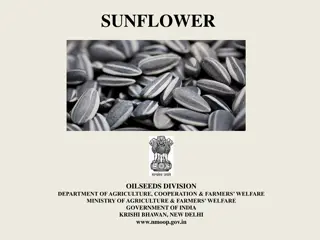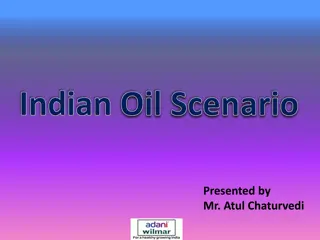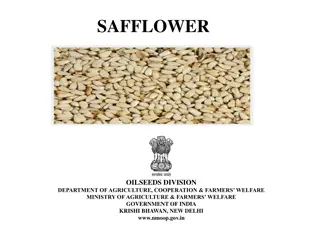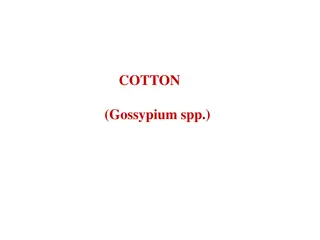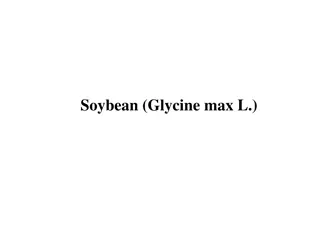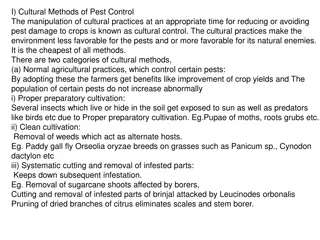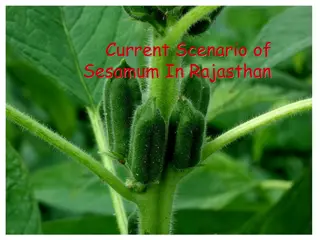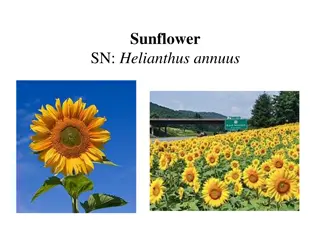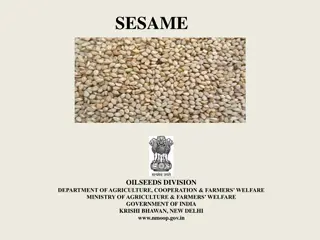Overview of Castor Oilseed Cultivation in India
Castor oilseed cultivation in India is a significant agricultural activity, with detailed information on botanical description, seasonal preferences, global vs. national scenarios, major producing countries, national scenarios, and key growing states. The content sheds light on cultivation practices, productivity, and regions suitable for castor cultivation.
Download Presentation

Please find below an Image/Link to download the presentation.
The content on the website is provided AS IS for your information and personal use only. It may not be sold, licensed, or shared on other websites without obtaining consent from the author. Download presentation by click this link. If you encounter any issues during the download, it is possible that the publisher has removed the file from their server.
E N D
Presentation Transcript
CASTOR OILSEEDS DIVISION DEPARTMENT OF AGRICULTURE, COOPERATION & FARMERS WELFARE MINISTRY OF AGRICULTURE & FARMERS WELFARE GOVERNMENT OF INDIA KRISHI BHAWAN, NEW DELHI www.nmoop.gov.in
BOTANICAL DESCRIPTION Family: Euphorbiaceae Common name : Arandi Scientific name : Ricinus communis Origin : Ethiopia
SEASON AND CLIMATE Season : Usually kharif, but as a rabi crop in Andhra Pradesh and Odisha Climate : Can withstand long dry spells, but susceptible to water lodging Temperature : Moderate temperature (200-260C) with low humidity gives best yield
GLOBAL vs NATIONAL SCENARIO Globally castor is cultivated in more than 29 countries over an area of 14.48 lakh ha during 2014-15 with a production of 19.48 lakh tonnes and productivity of 1346 kg/ha India has the largest area (11.48 lakh ha) and highest productivity (1666 kg/ha) of Castor in the world
AREA, PRODUCTION AND YIELD OF MAJOR CASTOR PRODUCING COUNTRIES Sr. No. Country Area (lakh ha) 2013- 14 Production (lakh tonnes) 2012- 13 14 Yield (kg/ha) 2013- 14 2012- 13 2014 -15 2013- 2014- 15 2012- 13 2014- 15 1 India 11.48 10.96 10.40 19.64 16.44 17.33 1711 1500 1666 2 China 1.20 0.57 0.46 1.10 0.50 0.40 917 877 870 3 Brazil 0.84 0.44 0.64 0.26 0.13 0.38 308 287 592 4 Paraguay 0.06 0.08 0.08 0.10 0.11 0.09 1667 1375 1125 5 Thailand 0.03 0.02 0.01 0.02 0.01 0.01 688 722 727 World 16.48 14.91 14.48 32.39 18.44 19.48 1358 1237 1346 Source: Oilseeds Statistics: A Compendium. 2015, ICAR-Indian Institute of Oilseeds Research, Hyderabad
NATIONAL SCENARIO Irrigated intensive cultivation with hybrids: Gujarat and Rajasthan Rainfed cultivation coupled with low input application and varieties: Andhra Pradesh, Karnataka, Tamil Nadu, Telangana and Odisha etc
AREA, PRODUCTION AND YIELD OF MAJOR CASTOR GROWING STATES IN INDIA State Area (lakh ha) Production (lakh tonnes) Yield (kg/ha) AP 0.97 0.60 593 Gujarat 6.81 46.86 1987 Karnataka 0.11 0.08 685 Maharashtra 0.15 0.04 301 Odisha 0.12 0.17 637 Rajasthan 2.03 2.97 1452 Telangana 0.50 0.24 471 All India 10.63 17.49 1644
POTENTIAL STATES AND DISTRICTS Sr. No. State Districts Avg. area 2009-10 to 2011-12 (`000 ha) Banaskantha 116.00 1 Gujarat Kutch 87.00 Patan 75.57 Sabarkantha 67.30 Mehsana 66.03 Surendranagar 51.10 Ahmedabad 27.80 Gandhinagar 27.57 Vadodara 18.47 Rajkot 14.57 Kheda 13.53
POTENTIAL STATES AND DISTRICTS (contd) Sr. No. State Districts Avg. area 2009-10 to 2011-12 (`000 ha) 80.93 Jalore 2 Rajasthan 38.40 Sirohi 31.61 Barmer 28.69 Jodhpur
POTENTIAL STATES AND DISTRICTS (contd) Sr. No. State Districts Avg. area 2011-12 to 2013-14 (`000 ha) 78.26 Mahboobnagar 3 Telangana Nalgonda 6.10 Kurnool 42.18 4 Andhra Pradesh 22.01 Ananthapuram 10.97 Prakasam
NEW/ NON-TRADITIONAL AREAS Rabi season offers good scope for area expansion with higher productivity and least problem of Botrytis. There are bright prospects for growing castor in non-traditional areas like coastal regions where kharif castor crop is not possible due to biotic (Botrytis) and a-biotic (cyclone & water logging) stresses. Non-traditional areas/season also offer opportunity for off-season seed production in isolation.
CROPPING SYSTEMS Castor is raised either as a sole crop or mixed crop with kharif cereals/millets (sorghum, finger millet, pearl millet, maize), groundnut, green gram, black gram, cowpea and horse gram) and sometimes with horticultural crops like chillies, turmeric, ginger, broad bean and cucumber legumes (pigeonpea, Most popular inter-cropping, which are widely adopted by the farmers include castor + pigeon pea, castor + groundnut, castor + millets and castor + moth bean
PREFERRED HYBRIDS VARIETIES State Type Recommended varieties/hybrids Andhra Pradesh Varieties Jyothi, Kranti, Kiran, Haritha, 48-1(Jwala) Hybrids GCH-4, DCH-32, DCH-177, PCH-1, DCH 519 Gujarat Varieties VI-9, GAUC-1, SKI-73 (GC 2), 48-1, GC-3 Hybrids GAUCH-1, GCH-2, GCH-4, GCH-5, GCH-6, GCH-7, DCH-519 Karnataka Varieties RC-8, Jyothi, 48-1 Hybrids GCH-4, DCH-32, DCH-177, DCH-519 Maharashtra Varieties Jyothi, AKC-1, 48-1 Hybrids GCH-4, DCH-177, DCH-32, DCH-519
PREFERRED HYBRIDS VARIETIES (contd) State Type Recommended varieties/hybrids Rajasthan Varieties Jyothi, 48-1 Hybrids GCH-4, GCH-5, DCH-32, RHC-1, DCH- 177, DCH-519 Tamil Nadu Varieties SA-2, TMV-5, TMV-6, Jyothi, Co-1, 48-1 Hybrids GCH-4, DCH-32, TMVCH-1, DCH-177, DCH 519, YRCH-1 Uttar Pradesh Varieties T3, T4, 48-1, Kalpi-6, Chandra Prabha Haryana & Punjab Varieties CH-1, Jyothi, 48-1 Hybrids GAUCH-1, GCH-2, GCH-4, GCH-5, DCH-32, DCH-177, DCH-519
YIELD GAP IN CASTOR Irrigated Condition: State Kharif-2013 FLD SAY Yield Gap (%) Andhra Pradesh 648 1249 92.75 Gujarat 2054 3021 47.08 Rajasthan 1465 3666 150.24 Mean 1624 2436 50% Source: NMOOP Frontline Demonstrations on Oilseeds 2013-14, ICAR-IIOR, Hyderabad
PACKAGE AND PRACTICES Seed Bed Preparation: Deep summer ploughing helps to break the hard soil pan and facilitates easy root penetration apart from controlling weeds, insect pests and diseases Sowing: Castor is generally sown in line with country plough or seed-cum-ferti drills Seeding Time: Optimum seeding time for rainfed castor is second fortnight of June. Under irrigated condition sowing continued upto end of August
PACKAGE AND PRACTICES (contd) Quality Seed: Purchase of hybrid seeds every year and renewal of seed stockof improved varieties once in 4-5 years Spacing and Plant Population: Plant population of 18,500/ha and 14,000/ha was found to be optimum for rainfed and irrigated areas respectively with 5 kg seeds/ha
PACKAGE AND PRACTICES (contd) State-wise Recommended Spacing: State / Region Situation Andhra Pradesh Normal Rainfed Delayed Rainfed Karnataka Rainfed Irrigated Tamil Nadu Rainfed Maharashtra Normal Rainfed Delayed Rainfed Gujarat North-west Gujarat Rainfed Irrigated Saurashtra Rainfed Rajasthan Irrigated Spacing (cm) 90x60 60x30 60x30 90x60 90x60 90x60 60x30/90x20 90x60 120x60 120x60 90x60
PACKAGE AND PRACTICES (contd) Seed Treatment: Seed treatment with Thiram or Captan @ 3g/kg seed or Carbendazim 2 g/kg protects plants from seed borne diseases like Alternaria leaf blight, seedling blight and wilt Treating the seed with Trichodermaviride @ 10 g/kg seed and soil application of 2.5 kg incubated in 125 kg FYM/ha help in managing wilt Soaking the seed with 1% sodium chloride (common salt) for 3 hours before sowing imparts tolerance to sodicity wherever the problem exists
PACKAGE AND PRACTICES (contd) Fertilizer Application: Castor crop with an yield of 10 qtl./ha removes 40 kg N, 9 kg P205 and 16 kg K20/ha under rainfed conditions Irrigated crop with a yield of 22.8 q/ha removes 84 kg N, 26 kg P205 and 31 kg K20/ha Application of 10-12 t FYM/ha helps in moisture retention and provides nutrition to the crop Nitrogen is normally used in split doses under irrigated condition and also under rainfed conditions subject to receipt of rains
PACKAGE AND PRACTICES (contd) State-wise Fertilizer Recommendation: State / Region Andhra Pradesh Rainfed Tamil Nadu Rainfed Karnataka Irrigated Rainfed Maharashtra Rainfed Rajasthan Irrigated Gujarat North Irrigated Rabi Gujarat Saurashtra Region Gujarat Other Regions Situation N 60 30 75 40 60 80 120 80 120 P205 40 15 50 40 30 50 25 50 50 K2O 30 15 25 20 0 0 0 0 0 S - - - - - 20 - - 20 Irrigated Rainfed 100 50 0 20
PACKAGE AND PRACTICES (contd) Irrigation: All hybrids/varieties require 5-7 irrigations in sandy loam soils of Gujarat and Rajasthan for realizing the full productivity potentials Drip irrigation in hybrid castor saves 24% water and offers 36% higher yield
PACKAGE AND PRACTICES (contd) Weeding and Inter-culture: Two or three weeding at 15-20 days intervals are required to keep weeds under check Alternatively herbicides such as Fluchloralin or Trifluralin @ 1.0 kg a.i./ha or pre-emergence application of Alachlor @ 1.25 kg a.i./ha is equally effective under irrigation pre-sowing application of
PACKAGE AND PRACTICES (contd) Crop Protection: Insects Integrated Management Red Hairy Caterpillar (Amsacta albistriga Wlk.) Set up light traps on community basis with the first monsoon rains to attract the moths and kill them. Sow cucumber along with castor. Place the twigs of Ipomoea, Jatropha and Calotropis to attract the migrating caterpillars and kill them mechanically. Spray of Monocrotophos (0.05%) or Fenvalerate (0.02%) or Quinalphos (0.05%). Semilooper (Achoea janata L.) Hand picking of older larvae during early stages of crop growth. Manipulate parasitic activity by avoiding chemical spray, when 1-2 larval parasites are observed on castor plant. Spray of Monocrotophos (0.05%), Endosulfan (0.07%), if 4-5 semiloopers/plant are observed with more than 25% defoliation.
PACKAGE AND PRACTICES (contd) Crop Protection: Insects Integrated Management Tobacco Caterpillar (Spodoptera litura Fabr.) Collect and destroy egg masses and gregarious stages of the larvae along with damaged leaves. Spray Chlorpyrifos (0.05%) or Monocrotophos (0.05%) if defoliation is above 25%. Spray Monocrotophos (0.05%) or dust the spike with Quinalphos (1.5%) if more than 10% capsules are damaged. Capsule Borer (Dichocrosis punctiferalis) Leaf Hopper (Empoasca flavescens Fabr.) Grow double/ triple bloom genotypes like GCH-4, DCS-9, GCH-5, 48-1 etc. Spray Monocrotophos (0.05%) or Dimethoate (0.05%). Repeat spray, if required, after a fortnight. Whitefly (Trialeurodes ricini Misra) Spray Monocrotophos (0.05%) or Dimethoate (0.05%). Repeat spray, if required, after a fortnight. Red Spider Mite (Tetranychus telarius L.) Spray Dicofol (0.05%).
PACKAGE AND PRACTICES (contd) Crop Protection: Diseases Wilt (Fusarium oxysporum) millet/finger millet or cereals. Avoid water logging. Grow tolerant/resistant varieties like Jyoti, Jwala, Harita, GCH-4, DCH-32, GCH-5, DCH-177, 48-1 and DCH-519. Intercropping castor + pigeonpea 1:1. Treat the seed with Carbendazim 2 g/kg seed/Trichoderma viride 10 g/kg seed and soil application of 2.5 kg/ha incubated in 125 kg FYM. Root rot/die back (Macrophomina phaseolina L.) Maintain sufficient soil moisture through soil moisture conservation practices and irrigation at critical stages. Treat the seed with Thiram @ 3g/kg or Carbendazim 2g/kg seed or Trichoderma viride, 4 g/kg seed. Grey rot (Botrytis ricini) close spacing. Remove infected spikes/capsules and destroy. Provide additional dose of 10 kg N/ha after cessation of rains/ cyclonic storms. Spray Carbendazim (0.05%) or Thiophanate methyl (0.05%) before onset of cyclonic weather based on weather forecast. Integrated Management Avoid continuous cultivation of castor and rotate with pearl Burn and destroy crop debris. Follow crop rotation with cereal crops. Grow tolerant varieties like Jwala, and JHB-665. Use of non spiny varieties (48-1). Adopt wider spacing and avoid
PACKAGE AND PRACTICES (contd) Harvesting and Threshing: The main spike becomes ready for harvest within 90-120 days after planting. Subsequent pickings can be taken up at intervals of 30 days Physiological maturity in castor is attained when some of the capsules in a spike turn brown in colour The matured spikes are cut and dried in sun for few days for easy threshing Threshing is usually done by either beating the capsules with sticks or alternatively by trampling with Bullocks or Tractor wherever possible Power operated mechanical threshers are also available for the purpose
EXPORT OF CASTOR OIL & OIL MEAL Commodity 2012-13 Quantity (lakh tonnes) crores) 2013-14 Quantity (lakh tonnes) 2014-15 Quantity (lakh tonnes) Value (Rs. in Value (Rs. in crores) Value (Rs. in crores) 5.28 3966.54 5.05 3995.47 5.06 4304.08 Castor oil and its fractions Hydrogenated castor oil Oil cake and meal Others 0.37 328.52 0.38 356.40 0.40 393.65 4.08 224.02 6.02 351.86 5.20 366.95 0.30 30.13 0.019 43.67 0.06 16.54 Total 10.03 4549.21 11.47 4747.40 10.72 5081.22
MARKET PRICE OF CASTOR SEED Market Price (Rs./qtl) MSP* State Market 3351.00 - Andhra Pradesh Kurnool 3775.00 - Gujarat Vijapur 3775.00 - Kadi *Not available
USE OF PRODUCTS AND BY-PRODUCTS Products / By-products Green leaves As a feed for eri silk worm Powdered leaves As repellants for aphids, mosquitoes, and mites Stem pulp Paper and straw boards Castor lipase Laundering and dry cleaning formulations Uses Nutritive food called Ogilli-isi or Awka Cotyledon of dry seed without testa Castor oil Medicinal cathartic, prevent hair losses Industrial - lubricants, oleo-chemicals, plastics, surfactants, cosmetics, urethanes, coatings, etc. - laxative, purgative and Castor oil
RESEARCHABLE ISSUES Intensive evaluation of germplasm for agro- economic traits and resistance to wilt, Botrytis, leaf hopper and capsule borer Development of bio-intensive integrated pest management strategies for wilt, Botrytis and capsule borer Development of transgenic for resistance to Botrytis Value addition of raw castor oil for oleo-chemicals
ISSUES / ACTIONABLE POINTS ICAR /SAUs may develop high yielding hybrids / varieties with resistance to major diseases and pests and wider adaptability Productivity level of Maharashtra, Telangana and Andhra Pradesh is very low as compared to national average for which the States may make special efforts Value addition of Castor oil for improving export potential


